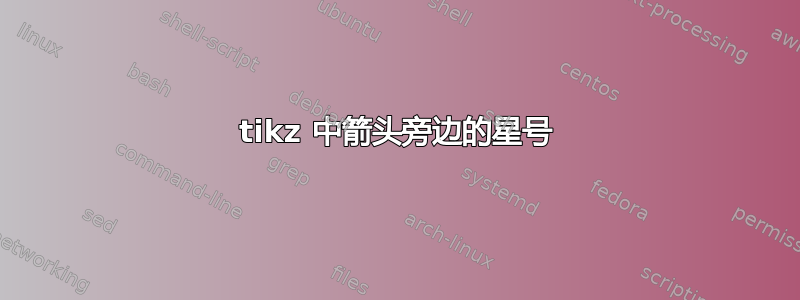
在 TikZ 绘图中绘制$\to^*$箭头的最佳方法是什么?到目前为止,我能想到的最好的方法是
\draw[->] (A) to node[very near end] {$*$} (B);
答案1
这里有一些想法。
第一个是 ,to path带有一个由 组成的额外节点$ {} ^ * $。
第二个引入了两个箭头,即to*和*to。由于箭头会变形,我添加了*to起始线的箭头,星号应出现在该线的左侧。
代码中有一个注释掉的解决方案,其中的原始命令在$\scriptstyle *$文档\pgftext中多次使用箭头时不起作用。
代码
\documentclass{article}
\usepackage{tikz}
\usepgflibrary{plotmarks}
\tikzset{
to*/.style={
shorten >=.25em,#1-to,
to path={-- node[inner sep=0pt,at end,sloped] {${}^*$} (\tikztotarget) \tikztonodes}
},
to*/.default=
}
\makeatletter
\pgfarrowsdeclare{to*}{to*}
{
\pgfutil@tempdima=-0.84pt%
\advance\pgfutil@tempdima by-1.3\pgflinewidth%
\pgfutil@tempdimb=0.21pt%
\advance\pgfutil@tempdimb by.625\pgflinewidth%
\advance\pgfutil@tempdimb by2.5pt%
\pgfarrowsleftextend{+\pgfutil@tempdima}
\pgfarrowsrightextend{+\pgfutil@tempdimb}
}
{
\pgfutil@tempdima=0.28pt%
\advance\pgfutil@tempdima by.3\pgflinewidth%
\pgfsetlinewidth{0.8\pgflinewidth}
\pgfsetdash{}{+0pt}
\pgfsetroundcap
\pgfsetroundjoin
\pgfpathmoveto{\pgfqpoint{-3\pgfutil@tempdima}{4\pgfutil@tempdima}}
\pgfpathcurveto
{\pgfqpoint{-2.75\pgfutil@tempdima}{2.5\pgfutil@tempdima}}
{\pgfqpoint{0pt}{0.25\pgfutil@tempdima}}
{\pgfqpoint{0.75\pgfutil@tempdima}{0pt}}
\pgfpathcurveto
{\pgfqpoint{0pt}{-0.25\pgfutil@tempdima}}
{\pgfqpoint{-2.75\pgfutil@tempdima}{-2.5\pgfutil@tempdima}}
{\pgfqpoint{-3\pgfutil@tempdima}{-4\pgfutil@tempdima}}
\pgfusepathqstroke
\begingroup
\pgftransformxshift{2.5pt}
\pgftransformyshift{2pt}
\pgftransformscale{.7}
\pgfuseplotmark{asterisk}
\endgroup
% \pgftext[left,y=2pt]{$\scriptstyle *$}
}
\pgfarrowsdeclare{*to}{*to}
{
\pgfutil@tempdima=-0.84pt%
\advance\pgfutil@tempdima by-1.3\pgflinewidth%
\pgfutil@tempdimb=0.21pt%
\advance\pgfutil@tempdimb by.625\pgflinewidth%
\advance\pgfutil@tempdimb by2.5pt%
\pgfarrowsleftextend{+\pgfutil@tempdima}
\pgfarrowsrightextend{+\pgfutil@tempdimb}
}
{
\pgfutil@tempdima=0.28pt%
\advance\pgfutil@tempdima by.3\pgflinewidth%
\pgfsetlinewidth{0.8\pgflinewidth}
\pgfsetdash{}{+0pt}
\pgfsetroundcap
\pgfsetroundjoin
\pgfpathmoveto{\pgfqpoint{-3\pgfutil@tempdima}{4\pgfutil@tempdima}}
\pgfpathcurveto
{\pgfqpoint{-2.75\pgfutil@tempdima}{2.5\pgfutil@tempdima}}
{\pgfqpoint{0pt}{0.25\pgfutil@tempdima}}
{\pgfqpoint{0.75\pgfutil@tempdima}{0pt}}
\pgfpathcurveto
{\pgfqpoint{0pt}{-0.25\pgfutil@tempdima}}
{\pgfqpoint{-2.75\pgfutil@tempdima}{-2.5\pgfutil@tempdima}}
{\pgfqpoint{-3\pgfutil@tempdima}{-4\pgfutil@tempdima}}
\pgfusepathqstroke
\begingroup
\pgftransformxshift{2.5pt}
\pgftransformyshift{-2pt}
\pgftransformscale{.7}
\pgfuseplotmark{asterisk}
\endgroup
% \pgftext[left,y=-2pt]{$\scriptstyle *$}
}
\makeatother
\newcommand*{\testtostar}[1]{%
\tikz[baseline=(A.base)]{
\node (A) {$A$}; \node at (1,0) (B) {$B$};
\draw[arrows=#1] (A) -- (B);}%
}
\begin{document}
$ A \to^* B$
\tikz[baseline=(A.base)]{
\node (A) {$A$}; \node at (1,0) (B) {$B$};
\path (A) edge[to*] (B);}
\testtostar{-to*}
\testtostar{to*-}
\testtostar{to*-to*}
\testtostar{-*to}
\testtostar{*to-}
\testtostar{*to-*to}
\testtostar{*to-to*}
\testtostar{to*-*to}
\end{document}
输出



